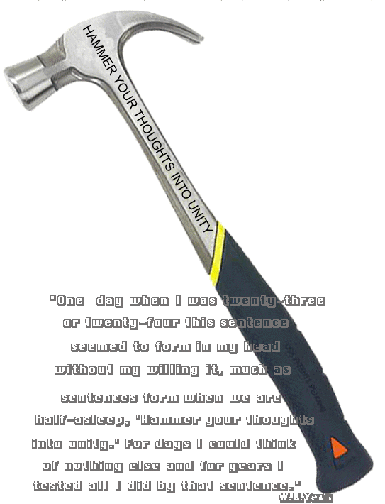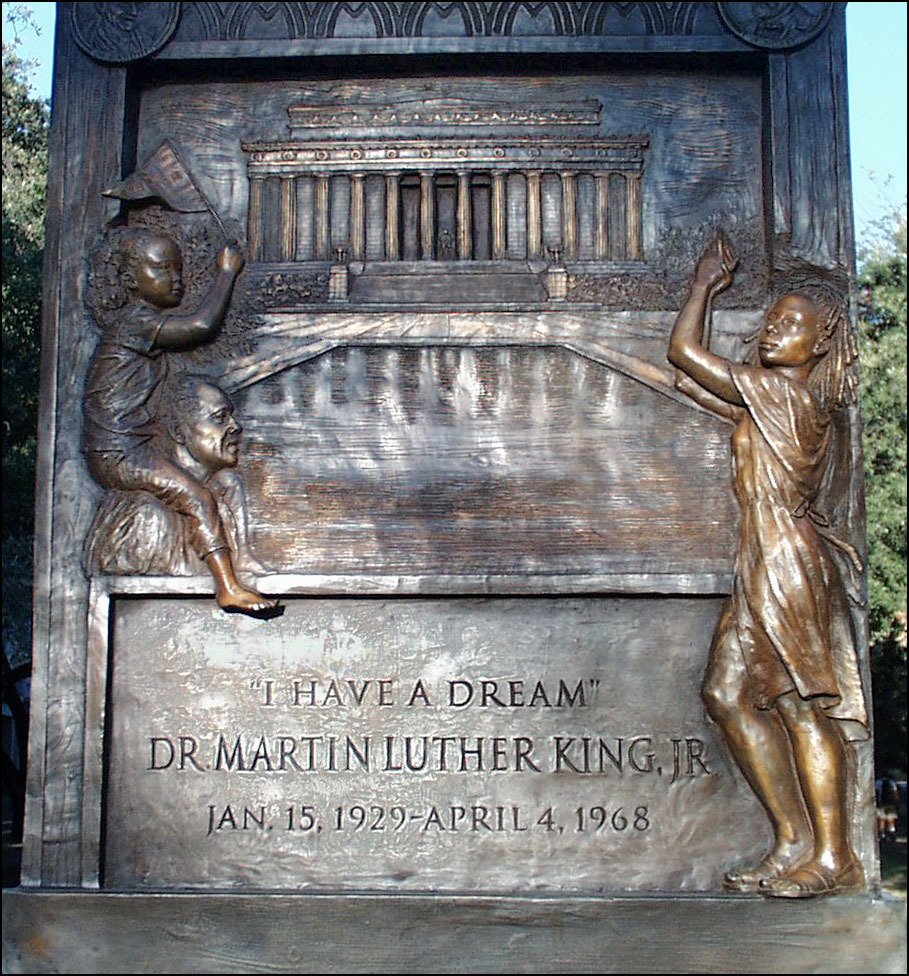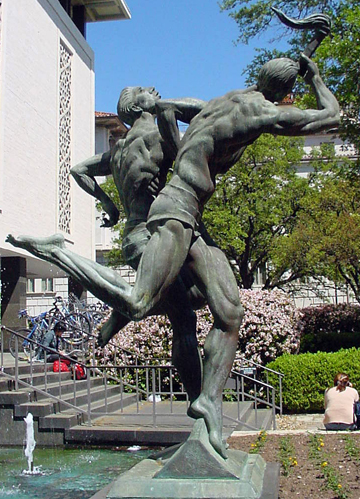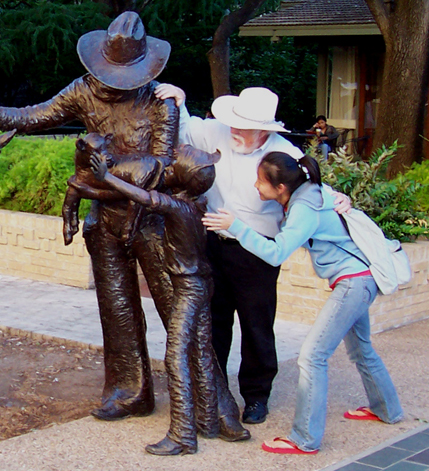
‘One
day when I was twenty-three or twenty-four this sentence seemed to
form in my head, without my willing it, much as sentences form when we are
half-asleep, ‘Hammer your thoughts into unity’.
For days I could think of nothing else and for years I tested all I did by that
sentence [...]” William Butler Yeats (cited in Frank Tuohy, Yeats, 1976,
p.51 )







This is an essay of at least fourteen hundred words (four pages or so) of your passions, and to some extent, your pilgrimage, your truths, and your awareness of your own learning styles and creative processes. ONE OF THE PRIMARY GRADING CRITERIONS WILL BE HOW WELL YOU CAN RELATE VICTORIAN LITERATURE, ESPECIALLY OUR ASSIGNED READINGS, TO YOUR PASSIONS. YOUR CONNECTIONS SHOULD BE BACKED UP BY QUOTES WITH DOCUMENTATION OF THE SOURCES. Ultimately, however, the emphasis is on coherence, hammering your thoughts and feelings into unity.
This assignment is inspired specifically by the official "Core Purpose of the University" -- To transform lives for the benefit of society" -- and by its six core values: "Discovery, Freedom, Leadership, Individual Opportunity, and Responsibility."

The one we will be focusing on is "Leadership." To understand the purposes and goals of projects one and two in this course read Leadership carefully.

THEN YOU ARE TO FOLLOW THE INSTRUCTIONS IN THE ANTHOLOGY IN THE ESSAYS "YOUR PERSONAL VISION" AND "DISCOVERING THE LEADER IN YOU."
TO SEE THE CONNECTION WITH FEELINGS AND PASSIONS SEE THE ESSAY "LEADERSHIP AND E.Q."
AN EXAMPLE OF A FRESHMAN'S PERSONAL VISION FOCUSING ON A PASSION: Will
SOME
EXAMPLES OF FRESHMAN LEADERSHIP VISIONS THAT INCLUDE PERSONAL VISIONS:
HAVING PRODUCED A ROUGH DRAFT FOLLOWING THESE INSTRUCTIONS, CONSIDER THESE POSSIBILITIES:
This is an essay in which you are to discover and communicate, first of all, what you are most passionate about, and thus what your pilgrimage is, and what truth[s] you seek and/or have found that will set you free.

As the image of the scallop shell below the motto on the tower reminds us, particularly important are pilgrimage goals that can endow you with a compelling vision that inspires others to follow you. Hence especially valuable are passions that tap into that which is greater than the self, passions that enable you to make a contribution to society that can be thought of as your legacy when you are gone. Think of the freshman as described by Newman in Leadership. Perhaps, in describing the pattern of conversion in the freshman, he is describing you: perhaps you have already experienced at least one "sensation which perhaps he never had before. He has a feeling not in addition or increase of former feelings, but of something different in its nature. He will perhaps be borne forward, and find for a time that he has lost his bearings. He has made a certain progress, and he has a consciousness of mental enlargement; he does not stand where he did, he has a new centre, and a range of thoughts to which he was before a stranger... We seem to have new faculties, or a new exercise for our faculties, by this addition to our knowledge; like a prisoner, who, having been accustomed to wear manacles or fetters, suddenly finds his arms and legs free. ... But now every event has a meaning; they have their own estimate of whatever happens to them; they are mindful of times and seasons, and compare the present with the past; and the world, no longer dull, monotonous, unprofitable, and hopeless, is a various and complicated drama, with parts and an object, and an awful moral."
Consider to what extent you have transcended the accidents of being born in a particular place and time, molding your own character, finding your own truths that set you free. For example, what you would say to a visitor if you were asked 'What is your dream?'

In other words, if your life were to end now what would the torch represent that you would pass on to the next generation.

Specifically, what would you, as the old cowboy in the sculpture, Generations, in front of the Texas Exes, say to the next generation.

Focusing on your passions and perhaps one or more of these unifying themes,
“Hammer your thoughts into unity.
To do this you may well have to accept the fact that you have many different passions. To achieve unity you will probably need to choose just one of these passions or at least just one cluster of related passions. You can mention your other passions in the beginning of the essay, but will need to narrow the focus soon to the passion[s] that enable you to write the most coherent and unified essay at this time in your life.
As you compose this essay, you will be hammering your self into unity. The word "compose" connects "pose," that is "to place," to "con" ("together"), and its root meaning is thus "to place together," "To put together (parts or elements) so as to make up a whole" (O.E.D.). As Newman puts it, your mind takes a" connected view of old and new, past and present, far and near, and ... has an insight into the influence of all these one on another; without which there is no whole, and no centre. It possesses the knowledge, not only of things, but also of their mutual and true relations." Such a mind "makes every thing in some sort lead to every thing else; it would communicate the image of the whole to every separate portion, till that whole becomes in imagination like a spirit, every where pervading and penetrating its component parts, and giving them one definite meaning."
As always, make sure you have a word count and follow all the other instructions. Use either the MLA or the U. of Chicago documentation system.
When you have composed yourself in this way, YOU ARE TO POST THE ESSAY ON THE PROJECT ONE DISCUSSION BOARD IN BLACKBOARD.
There are at least two ways you can do this.
[1] You paste the text into the text box and then you insert the pictures into the text where they belong as follows. Wherever a picture is to appear you put in the following HTML code. Example:
<img src="http://www.jahsonic.com/Gargoyle.gif">
You simply change this by putting the URL of your own picture between the quotation marks. [keep everything else the same including the quotation marks and the < and >] Your URL, of course, can refer to a file on your webspace account or in the Blackboard Content system: just call up your image on your browser and copy and paste the resulting URL into this code.
When you have done this with all your pictures, you are ready to submit the essay AFTER CHECKING "HTML" BELOW THE TEXT BOX TO THE RIGHT
When you have selected "HTML" submit the essay to the Discussion Board
[2] OR Save your essay as a web page and upload it and all related files to your Blackboard Content System,* or to your webspace account. Paste the link in the text box in the Blackboard Discussion Board system in the following format and upload it. Examples, the first from the Blackboard Content System, the second from webspace:
<a href="https://courses.utexas.edu/bbcswebdav/users/bump/projectone.htm">my project</a>
<a href="https://webspace.utexas.edu/bump/myprojectone.htm?uniq=-ngactw">my project</a>
You simply change one of these by putting the title of your project where you see myprojectone.htm and put the URL of your own essay between the quotation marks. [keep everything else the same including the quotation marks and the < and >] Your URL, of course, can refer to a file on your webspace account or in the Blackboard Content system: just call up your essay on your browser and copy and paste the resulting URL into this code.
When you have done this, you are ready to submit the link AFTER CHECKING "HTML" BELOW THE TEXT BOX TO THE RIGHT
When you have selected "HTML" submit the link to the Discussion Board
Then, if you have just put in a link to the essay itself, have someone else test it to make sure YOU HAVE SET PERMISSIONS TO "SHARE" in Blackboard or webspace.
Once you know yours is working, respond to the essays of others and then revise your own essay responding to their suggestions.
If yours is not working, you are facing one of the basic tests of proofreading: computers don't do what you want them to do; they do what you tell them to do. Machines have no forgiveness. There can be no mistake, however small, in the code, if it is to work.
PICTURES. Because visual rhetoric is a component of the grade for the course, you will get points for all relevant pictures. These include those related to yourself in the course that are on our website; all pictures of you in groups as well as all individual pictures of you and of work you have done, such as drawings or road maps. (Select "Class Pictures" on our course website and then go through the folders, identifying those that include you. As you write, incorporate the pictures (with captions, in color) in your text where they are discussed. The purpose of the pictures of yourself, of course, is to help you to stand outside yourself and see yourself as others see you. Hence it may be useful to discuss what you actually see in the picture . All pictures are to be placed in the text where they are most relevant. None are to be placed at the end in a gallery or whatever.
QUOTATIONS. As always you will get points for quotations from our readings and Victorian literature generally. You can quote more than once from one source but the first quote will be worth more. You can also quote from sources other than those assigned, but again these quotes will not be worth as much as the first quote from an assigned text.
http://www.utexas.edu/supportut/core_values/leadership.html
*Here are the relevant directions for what do after choosing "saving as a web page" in Word and looking at the files that resulted.
"The one you're looking for is "(filename).htm," so if your file is called "project1," the file you want is called "project1.htm." When this file is uploaded, you will have uploaded the written part of the project, but not the pictures.
5. When you saved the project in ".htm" format, Word also created a folder with the same name as your project to hold the multimedia files (read "pictures"). The default name of this folder is "(filename)_files"; (using the previous example it would be "project1_files").
